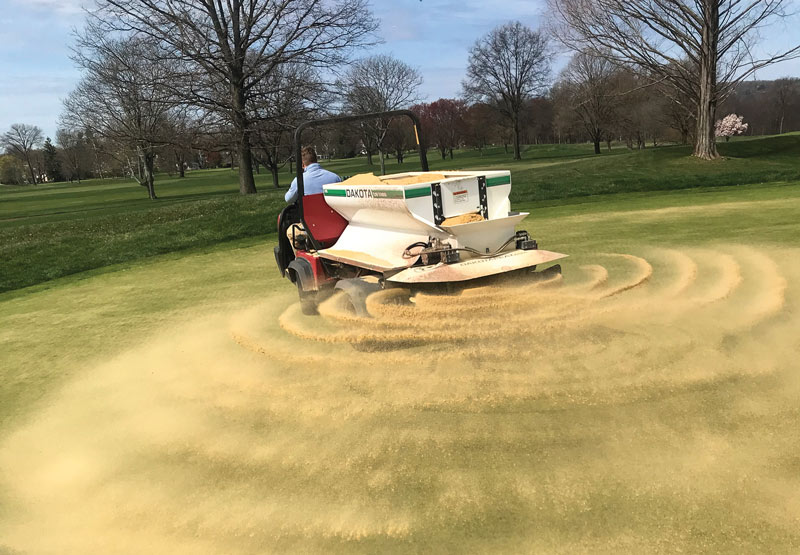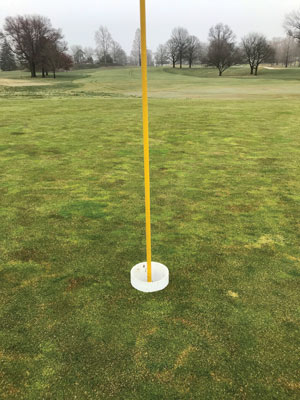
With limited staff resources on hand at Echo Lake Country Club in Westfield, N.J., in the wake of the coronavirus outbreak, superintendent Chris Carson switched from hollow to solid tines for aerification to add sand to greens’ soil profile. Photos courtesy of Chris Carson
In January and early February, concerns about coronavirus and COVID-19 began to grow throughout our country. In my home state of New Jersey, those concerns extended to its potential impact on golf.
Once March hit, the number of confirmed coronavirus cases began to grow at an alarming rate in our area (Echo Lake Country Club is just outside New York City), and over the first two weeks of the month, there was rising unease about the course the virus was taking.
By the middle of March, it was clear the pandemic that had hit so hard in other parts of the world had come to our shores. There was profound concern about the health of our communities and our memberships, and, consequently, about the viability of our golf businesses.
As the federal government struggled to get a handle on the scope of the problem, governors of the hardest-hit states became more and more engaged. New York City developed into the epicenter of the disease in the United States, and measures were taken in New York, New Jersey and Connecticut to mitigate its spread — to “flatten the curve.” Nonessential businesses — including golf courses — were ordered closed, social distancing practices were introduced to reduce the spread of the disease, and life as we knew it quickly changed.
While our national and state governments focused on the health and welfare of their constituents, our economy stopped in its tracks, and golf was one of the businesses affected. Superintendents and the facilities they work for were forced to make difficult decisions about how they would operate. In New Jersey, clubhouses were ordered closed when groups larger than 10 were prohibited by the state government. Though play wasn’t permitted, we were allowed to maintain our golf courses as long as we followed CDC regulations.
As you read this article, golf has returned in some form or fashion to the majority of the country, although with strict restrictions and safety measures in place. With each passing week, other new chapters in the COVID-19 pandemic are unfolding, and many conditions and regulations will change.
What will remain, however, are lessons learned during this crisis, especially as they relate to the business of golf. I’ve tried to pay close attention to how our state and industry have reacted to the coronavirus, and what follows are 10 key lessons I’ve learned throughout this experience. It is my belief that if we embrace the idea that setbacks are our chance to grow, they will help us prepare for the next emergency that hits.
1. Information is vital
Todd Raisch, CGCS, superintendent at Ridgewood Country Club in Paramus, N.J., and the current secretary of the GCSA of New Jersey, put together two surveys for chapter members. Sent early in the crisis and about a week apart, they asked simple questions. The first focused on how clubs were dealing with the problem, and the second, after golf had been shut down in New Jersey, asked how superintendents were adapting operations and budgets to deal with the new regulations.
The participation in these surveys was extraordinary, with well over 100 total responses each, and the results were sent out within one or two days of the survey. The responses helped fellow members adjust their programs and brought to light interesting perspectives and ideas that could be useful to their operations.
The lesson in this is that, amid a rapidly changing crisis, facts are vital, and the quicker our association could gather and disseminate information to its members, the better we were able to deal with the issues in front of us.
Facilities and superintendents are comforted during times of difficulty when they know that they aren’t in it alone and that a playbook for orderly responses is available. This is true even when, as in this case, the playbook is being written as the crisis unfolds.
2. Be prepared to share
Raisch’s ability to act quickly is evidence of his and our chapter’s preparation for member communication. Having set up a system for surveying and organizing and distributing information for previous, more benign initiatives, Raisch was ready to act when this time-critical emergency struck.
There are lessons in that for all associations. Whether it’s a natural event such a hurricane or tornado, a governmental decision that affects what we do, or a life-threatening pandemic, being ready to act with all the modern tools available to us is critical. Social media plays a key role in our ability to respond to issues, a point that was evident during this pandemic, as we are now able to canvas our chapter’s members and get their responses out quickly.
In the early days of the shutdown, the GCSA of New Jersey worked with the faculty at Rutgers University to produce an excellent video that reviewed the many questions that were at the top of superintendents’ minds (watch it below). Facilitated by Mike Tardogno, GCSAA Class A superintendent at Skyway Golf at Lincoln Park in Jersey City, N.J., the video offered practical solutions and ideas from our friends at Rutgers’ Center for Turfgrass Science, and gave the many hundreds of turfgrass professionals who viewed it an opportunity to hear from the experts on what could be done to help us get through the season with limited crews and inputs.
GCSAA has provided similar coronavirus resources and, in the process, displayed its ability to distribute timely information to its members. New regulations on employee layoffs and unemployment, for example, were discussed in depth during a COVID-19 online town hall meeting at the end of March (at press time for this issue, GCSAA had conducted six town hall meetings), which was timely information for the many members who were forced to unexpectedly reduce their staffs.
Editor’s note: View all of GCM’s coverage of coronavirus and golf, which includes the industry-wide Back2Golf resources and numerous firsthand reports from superintendents about how they’ve adapted their courses and operations.
3. Manage golfer/member expectations
As this issue of GCM was being prepared, restrictions on golf were being lifted in most parts of the country, and golfers were coming back to our courses eager to play and get away from the pressures they’d been enduring.
If they were to come back expecting normal conditions and instead find bunkers unprepared and many details neglected, they may be disappointed. But if they’ve been prepared through social media updates and other messaging, and they know the only thing that kept the golf course alive during this time was a skeleton team of maintenance workers, then they should be more understanding and, hopefully, appreciative of the effort.
Case in point: At Echo Lake, our quarterly newsletter was changed to an electronic weekly report that I used to update members on what we were doing on the course and how we would be ready to welcome them back once restrictions were lifted. In the reports, I reminded them of the many important procedures we undertake in spring to ensure our golf course can fight off pests, and I mentioned the modifications we had made to our operation plan that enabled us to continue to meet the course’s critical needs.
4. Get ahead of the curve
Superintendents are the leaders of their maintenance departments, and our clubs look to us during challenging times to define and explain the problems we’re confronting, and to offer solutions. At Echo Lake, our fiscal year is Nov. 1 through Oct. 31, so we were well into our budget year when the coronavirus changed everything. As the pandemic grew, it quickly became obvious that we needed to rethink our operations plan, and it was clear to me that I needed to lead that discussion. The decision-makers at my club appreciated the plan I presented to them — one that included a number of painful cuts but that addressed the situation head-on.
Dr. Anthony Fauci, director of the National Institute of Allergy and Infectious Diseases, affectingly said in one of his many press conferences, “We have to get to where the puck is going to be, not where it is now.”
With that in mind, GCSAA’s governmental advocacy initiatives showed their value during this time. Because we had already taken the time to build relationships in Washington, D.C., we had a network in place so that our voice would be heard. By working to develop these connections and share information with our elected representatives in recent years, our national association was better prepared to respond when it was needed, and once again answered the question, “What is GCSAA doing for me?”
5. Act decisively
Many clubs in the Northeast acted quickly to reduce staff by either laying off full-time crew members or delaying the return of seasonal employees. As painful as that was, the reality was that golf courses were facing a severe reduction in activity and revenue, and a response was needed. With all restaurants and nonessential retailers ordered closed in the state — including our clubhouses and pro shops — play stopped, outings were canceled, and cash flow quickly became problematic. Reducing payroll, our biggest expense, became the first adjustment most superintendents made.

During the initial days of the coronavirus pandemic, the GCSA of New Jersey fostered communication with its members, surveying them on what they were experiencing at their facilities, sharing that information among them, and advocating on their behalf with state and local officials.
Other adjustments were required as well. For example, at Echo Lake, we eliminated our application of fertilizer in the rough to save the cost of the material, the cost of applying that material and the cost of dealing with the rapid grass growth that would have ensued. We’ve changed our disease prevention program by altering some of our chemical choices and by stretching out our sprays, and we’ve eliminated almost all of our hand-cut areas by using larger machines on greens and tees.
As I’ve enacted these decisions, I’ve also explained to my board that there are consequences to these actions. My premise was clear: We would reduce our operation and our cultural activities to a minimum, but would remain positioned to quickly ramp up once restrictions eased. Communication is vital during troubled times, and I’ve done all I can to share our new goals and to be honest about what our members can expect when they come back to their club.
6. Be flexible
As we worked our way through this period, it was common that conclusions made in the morning were often moot after government pronouncements made in the afternoon, and the only possible response to these upheavals was to recalibrate, rethink the problem and revise our decision.
During a 15-day period, we went from “Will this affect golf?” to “How will we respond to the social distancing directive?” to “We are open, but with these restrictions” to “Our golf course is closed, but we are allowed to maintain it as long as CDC regulations are followed.”
Many state governors, with more at stake than the game of golf, acted boldly. Actions that early on were viewed by some as extreme or draconian are now viewed as prescient and lifesaving, a change that occurred in a short period. The lesson here is that we don’t always have all the data we need to be 100% sure of a decision, but in times of crisis, we often must analyze a situation, quickly make our best decision and move on. And if the outcome to this decision isn’t as we wish, or if circumstances change, we must promptly chart a new course.
7. Share knowledge
Superintendents’ management skills know almost no bounds; we are experts at adapting to changing conditions and finding imaginative solutions to difficult problems. That we also share our solutions with our peers is a testament to our sense of fraternity, and it’s evidenced by the many social media accounts of superintendents that offer any number of creative solutions.

Right: Like many golf facilities, Echo Lake Country Club has used elevated cup liners to prevent golfers from touching cups and flagsticks. The idea was shared widely among superintendents via social media.
Use of plant growth regulators, for example, will be expanded by many this year, especially in areas that normally don’t receive such products, and it’s comforting to know that many of our peers have shared their experiences with different materials. I’ve never regulated bunker banks, but I will be doing so this year, and I feel like I am going into that application well-armed with information provided by turf-growing friends.
8. Answer questions before they’re asked
If you propose a menu of budget cuts to temporarily deal with a problem, as I did this spring, bear in mind that often nobody knows when that situation will ease. By displaying your proposals in both monthly and annualized terms, your decision-makers will be better able to plan and adjust.
If you show a budget cut only as an annualized number, for example, the immediate question will be, “How much per month is that? Can you break that down for the months left in the year?” By anticipating that question and answering it before it gets asked, you will display the quality of leadership that clubs want from their superintendent.
Editor’s note: Read much more career and course management wisdom from Chris Carson in his articles 10 things I wish they’d taught me in turf school and Fire yourself! Tips for reinvigorating your golf course operation.
You should also discuss, even if only briefly, some of the consequences of the cuts you are proposing. Providing minimal maintenance to bunkers, for example, will save a lot of money for most courses, but it’s vital that your golfers understand that they won’t have the playing conditions they are used to when they return.
9. Seize learning opportunities
The 2008 financial crisis caused many golf courses to recalibrate their budgets and operating plans by analyzing all of their spending decisions and separating what was needed from what was wanted. As a result of this exercise, many superintendents learned to operate in the “zone of maximum productivity,” where a dollar invested returns at least that much value to the golfer providing the money.
Superintendents who survived that difficult period learned a lot about how far they can push their courses, and about how to manage their operations and the expectations of their members so that they may live to fight another day. Similarly, the decisions we make during this current period of uncertainty will help us prepare for our personal and business futures. If we view these decisions as opportunities to learn, we will emerge as stronger managers of our golf courses.
10. Be nimble
Superintendents who are inflexible in the way they do things set themselves up for problems when unexpected issues arise. We are at our best when we think creatively and thoughtfully, when we make quick decisions and adjust those decisions as circumstances warrant.
As Jim Gallagher, Echo Lake’s president, said incisively in the early stages of this current crisis: “The people and businesses that are going to flourish tomorrow are going to be those that are smart, nimble and think critically today.”
Chris Carson is the GCSAA Class A superintendent at Echo Lake Country Club in Westfield, N.J., and a three-time winner of GCSAA’s Leo Feser Award for the best superintendent-written article published in GCM. He is a 34-year member of GCSAA.